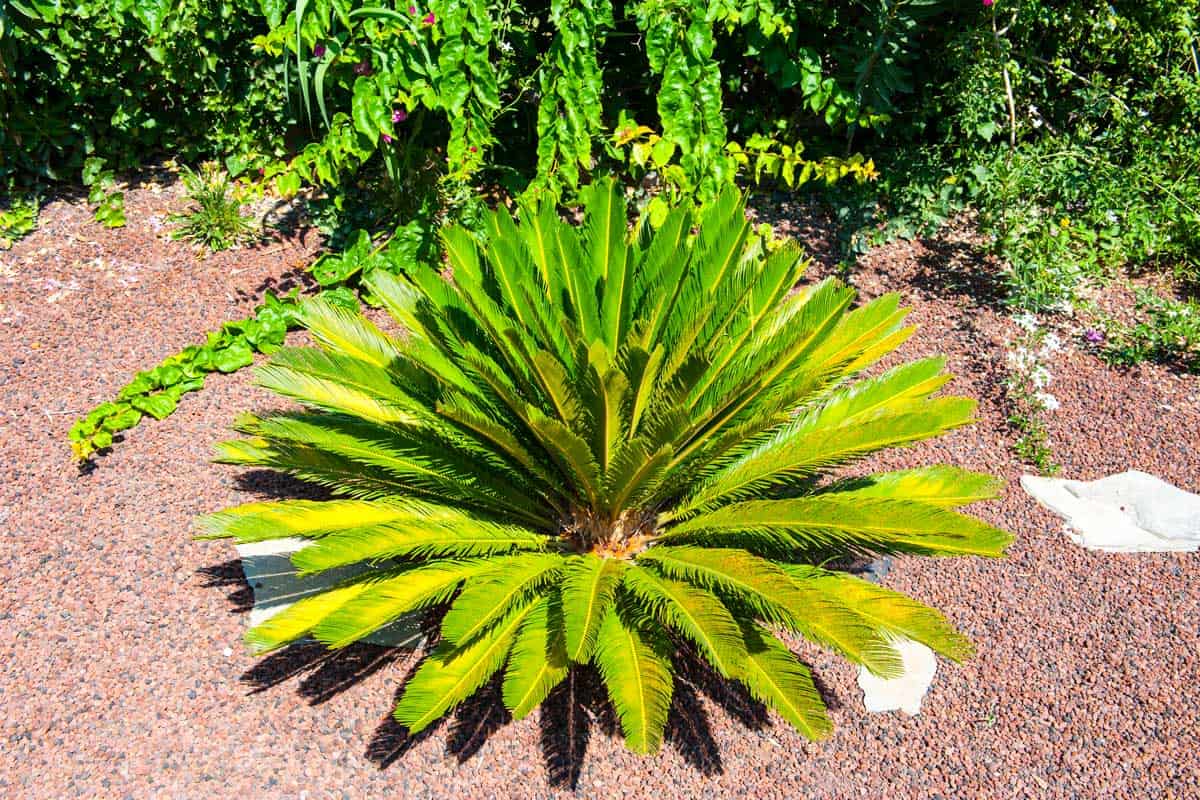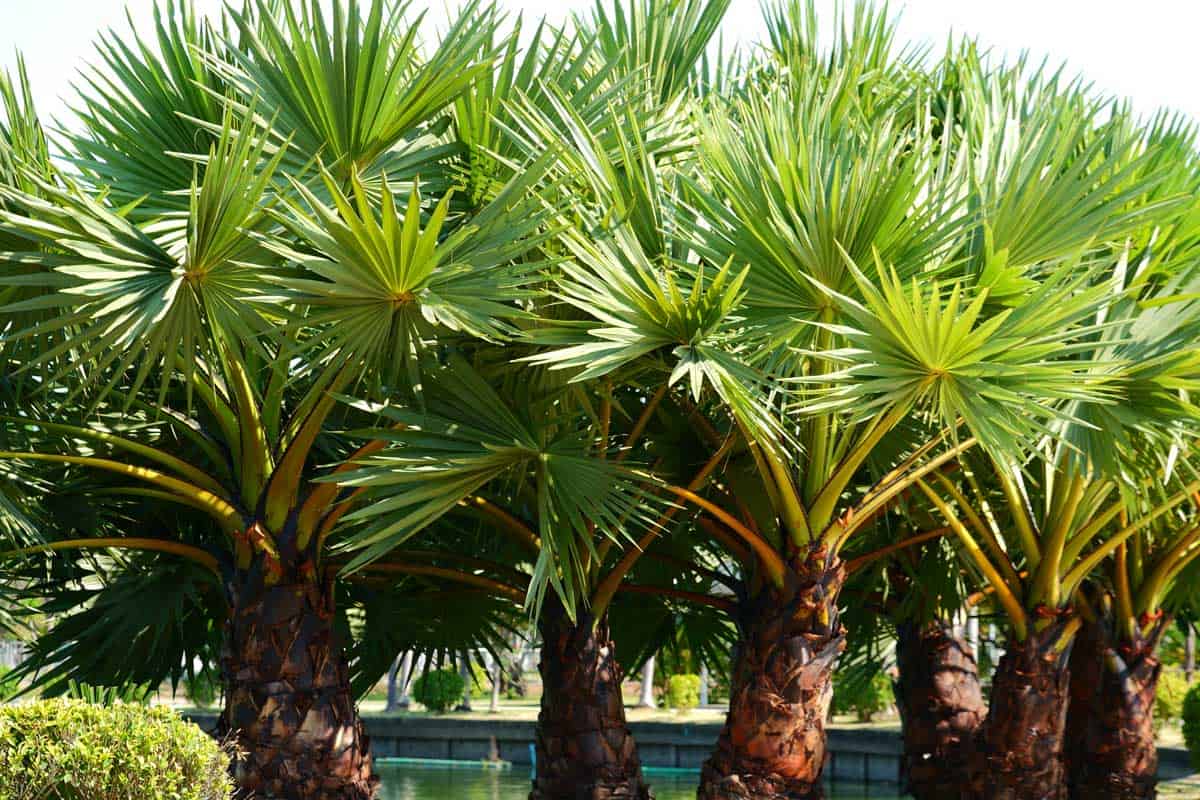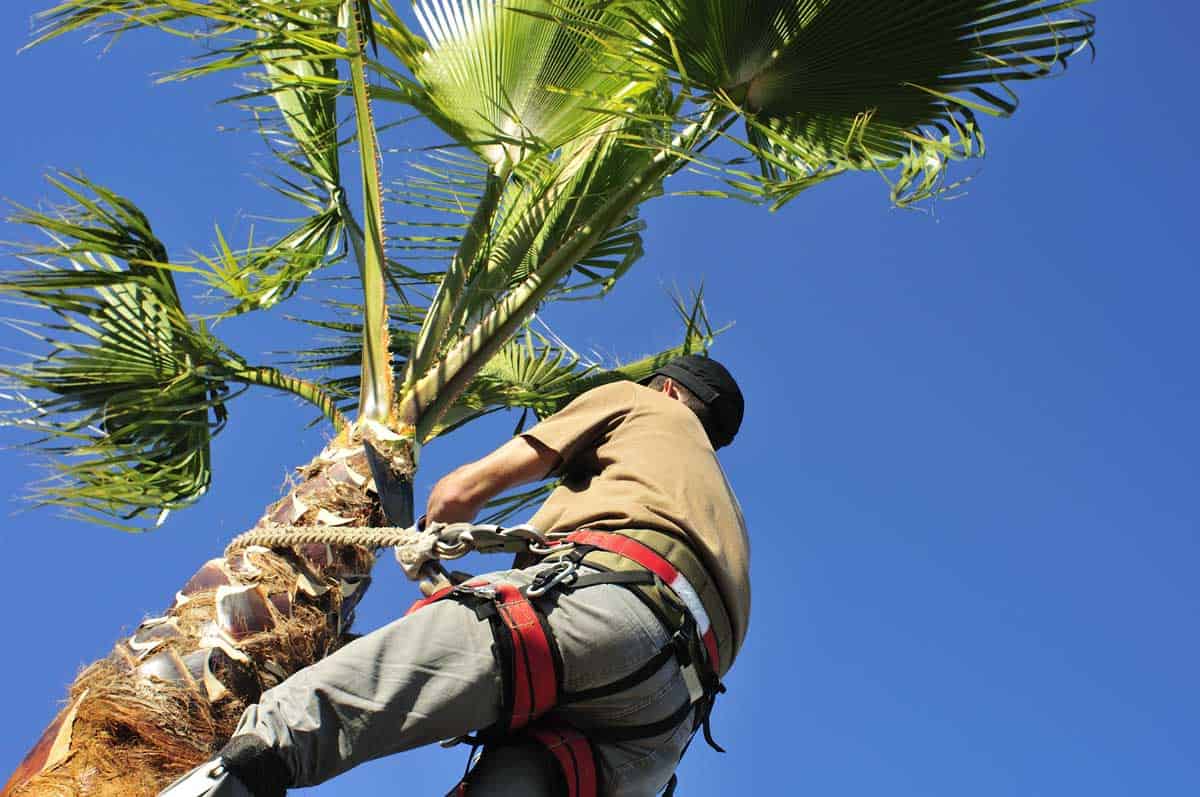 Tropical palm trees are a great addition to any home's decor or yard's landscape. Palms grow in a variety of sizes and shapes, bringing texture into your room or garden. Lush green, widespread fronds brighten every scene. While these trees are relatively low maintenance plants, you might wonder when to trim palm trees. We've done the research to provide you with the answer.
Tropical palm trees are a great addition to any home's decor or yard's landscape. Palms grow in a variety of sizes and shapes, bringing texture into your room or garden. Lush green, widespread fronds brighten every scene. While these trees are relatively low maintenance plants, you might wonder when to trim palm trees. We've done the research to provide you with the answer.
Palm trees can be trimmed throughout the year but, during warmer months is the best time to trim so the palm can recover and continue to grow afterward. Trim palm trees on an as-needed basis. You will know it is time to trim when you observe brown, completely dead fronds hanging from the tree. Only remove the brown, dead fronds because yellowed fronds are still providing nutrients to the tree. Excessive trimming can be detrimental to the palm tree's health.
Keep reading, and we'll share with you how to trim some of the most commonly used palms for indoor decor and outdoor landscaping. You'll learn the right tools to use and some helpful tips for keeping your palms vibrant year-round.
When to Trim a Majesty Palm?
The Majesty Palm (Ravenea glauca) is a common houseplant that adds a regal look to any room. This palm thrives in brightly lit spaces with moist soil and humid air. You can trim a Majesty Palm as needed during any time of the year but, trimming during warmer months is best for the palm's recovery.
How to Trim
Look for any fronds that are turning brown at the tips or are entirely brown. If the frond is entirely dead, it can be removed with a gentle tug. Otherwise, cut the browning frond cleanly at the stem by using scissor-like pruning shears.
What if Your Majesty Palm has Yellowing Fronds?
Yellowing tips or fronds, it might indicate that the Majesty Palm is not getting enough sunlight or moisture. Check the conditions of the palm's location and soil. There is no need to trim yellowing fronds, and they will return to green given the right growing conditions.
When to Trim a Pygmy Date Palm?

The feathery fronds of the Pygmy Date Palm (Phoenix roebelinii) are a lovely accent inside your home, on your deck, or near the poolside. Growing to heights between 6-feet to 10-feet, this palm is easily manageable as a potted tree. Pygmy Date Palms thrive in the USDA Plant Hardiness Zones 9-11 and should remain indoors for overwintering.
How to Trim
Trim a Pygmy Date Palm as needed during any time of the year but, trimming during warmer months will give the palm time to recover and continue to grow. Examine the tree in search of any brown, completely dead, or diseased fronds. Only these fronds should be removed. Leave any green or yellowed fronds because they are still providing nutrients to the palm.
Can You Trim Pygmy Palm Flower/Fruit Clusters?
The palm's clusters of flowers and fruits can be removed to suit your aesthetic appeal, but it is not necessary to prune clusters for the overall wellness of the palm.
When to Trim a Christmas Palm Tree?
Christmas Palm trees (Adonidia merrillii) are rapidly growing palms that make a festive addition to your outdoor, tropical landscape. Achieving heights of 20 to 25 feet, Christmas Palms produce clusters of red fruits that ripen during the holiday season. These palms thrive in USDA Plant Hardiness Zone 10.
How to Trim
Extremely low maintenance, Christmas Palms are self-cleaning and relatively disease-free trees. The palm drops dead fronds on its own throughout the year, leaving you with no need to trim but do a bit of grounds keeping to pick-up the fronds.
Can You Trim Christmas Palm Fruit Clusters?
It is your preference whether to trim the fruit clusters of the Christmas Palm. Some gardeners enjoy their colorful appeal, while others prefer to minimize the mess of dropping fruit by trimming off the clusters before they ripen.
When to Trim a Sago Palm Tree?

Technically not a palm, the Sago Palm (Cycas revoluta) is an ancient, woody perennial. Growing between 10 and 12 feet tall, Sago Palms gives an exotic appearance to the landscape and thrives in the USDA Plant Hardiness Zone 8-11. Sago Palms are toxic to people and animals, so use caution when trimming this plant and immediately discard the trimmings.
How to Trim
You can trim a Sago Palm as needed during any time of the year but, trimming during warmer months will give the palm ample recovery time. Remove only the brown, completely dead, or diseased fronds. Avoid removing fronds that are between 10 o'clock and 2 o'clock position.
Can You Prune a Sago Palm to Look Like a Tree?
If you prefer to shape your Sago Palm for a slender tree look, rather than its stout, bushy appearance, you can prune it carefully over several years. Shape the palm by removing the oldest fronds from the base of the palm. Cut the fronds as close to the palm's trunk as possible. Do this sparingly, from year to year.
Does Your Sago Palm Have Pups?
Mature Sago Palms develop offshoots near the base called pups. The pups can grow to be robust, but you can remove them while they are still small. Remove Sago Palm Pups during the spring or fall. Wiggle the pups loose or use a sharp knife to cut them away from the trunk. Plant the pup to grow a new Sago Palm.
When to Trim a Queen Palm Tree?
Queen Palms (Syagrus romanzoffiana) are stately trees, great for lining paths, that grow to be 50 feet tall. Straight trunks give rise to an overhead canopy of palms and fruit clusters. The best time to trim a Queen Palm is during spring and summer months.
How to Trim
You'll want to remove only the brown, completely dead leaves. Do not remove green fronds or browning fronds that still have green stems. Cut the frond at a horizontal angle as close to the tree's trunk as possible. Trim the trunk of Queen Palms near the canopy's undercarriage any time of year by removing dead plant material from the area.
Can You Trim Queen Palm Fruit Clusters?
Remove fruit clusters at your discretion for aesthetic appeal or as they begin to fall naturally to the ground. Trimming Queen Palm fruit clusters minimizes the occurrence of pests getting into your palm and keeps the ground below tidy.
What do You Trim Palm Tress With?

Trimming palm trees can be done safely and efficiently when you have the right tools and clothing for the job. It is recommended that you disinfect your pruning tools before and after trimming to prevent the spread of disease among plants. You can use a commercial disinfectant or diluted bleach solution to rinse the tools' blades and handles.
Clothing
Palms can have stiff, thorny fronds. When trimming palms, protect your skin by wearing a durable, long-sleeved shirt and long pants. Wear puncture-resistant gardening gloves with forearm protection.
Click here to find this on Amazon.
Eye protection is essential when trimming palms because you will be in proximity to falling debris and fronds. Wear a comfortable pair of safety glasses with a wrap-around, adjustable strap.
Click here to find this on Amazon.
Tools
A pair of scissor-like, pruning shears will work great for small palms with thin fronds like Majesty Palms.
Click here to find this on Amazon.
Loppers are best for medium frond palms like Pygmy Date and Sago Palms. The long handles help you to reach high fronds without the use of a stepladder.
Click here to find this on Amazon.
A pruning saw, with a razor-toothed blade, is an excellent choice for trimming thick palm fronds like those on Christmas Palms. Pruning saws are available in different sizes with blades ranging from 7 inches to 20 inches. You might also need a step stool or small ladder to reach these trees.
Click here to find this on Amazon.
For an extended reach on trees like Queen Palms, an electric pole chain saw is a handy tool. You might also need an extension ladder when trimming tall trees.
Click here to find this on Amazon.
Does Trimming Palm Trees Make Them Grow Faster?

Palms grow slowly, one leaf at a time, and generally take 5 to 10 years to mature depending on the species of palm. Trimming a palm does not help it to grow faster, and excessive pruning can damage the tree.
Try these tips to accelerate growth:
- Make sure outdoor and indoor palms get plenty of light.
- Keep your palms in a warm climate or provide artificial heat for outdoor plants during cooler months.
- Add nutrients to the soil by using a specially formulated palm fertilizer.
What Happens if You Don't Trim Palm Trees?
Palm trees that have not been trimmed can become hazardous. The dead hanging fronds, or petticoats, pose a threat to the property, people, and pets on the ground below.
Here are some excellent reasons to keep your palms trimmed:
- Avoid fires. Dead, dried fronds burn easily.
- Avoid injury. Palms naturally drop dead fronds. Massive, spiny fronds can land on unsuspecting people or pets below.
- Avoid property damage. Falling fronds can land on power lines, structures, and vehicles below.
- Avoid pests. Unkempt palm fronds invite pests like insects, rats, and snakes to make the tree home.
- Avoid spreading diseases to other trees. Pruning tools should be disinfected before and after you trim palm trees.
- Avoid unsightly landscaping. Trimmed fronds and fruit clusters mean less mess on the surrounding grounds and paths.
Palm trees will naturally drop dead fronds, ripe fruits, and seeds, so they do not need to be trimmed to stay healthy. But, you can keep your property safe and tidy by trimming palms as needed.
Will a Palm Tree Die if You Cut the Top Off?

Yes! Palm trees are monocot plants, meaning their trunk is a stem, and new growth occurs only from the top of the tree. If you cut off the top of a single trunk palm tree, the tree will die. Cutting the top of one or several trunks of a clustering palm will not kill the entire plant but, those cut stems will not regrow.
Palm trees do not grow out by producing new bark so, if the trunk of the palm is damaged, it cannot heal itself. The tree might survive trunk damage if the area dries completely and is not inflicted with excess moisture, disease, or insects.
A neatly trimmed, healthy palm will add a bit of paradise to your home or yard all year-round.






